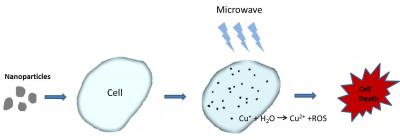Release date: 2016-10-18

In a new study, researchers from the Guangdong Provincial Key Laboratory of Orthopaedics and Implant Materials, Beijing University of Aeronautics and Astronautics and the University of Texas at Arlington found that the use of microwaves to activate photosensitive nanoparticles produces tissue heating effects. This ultimately leads to cell death in solid tumors. The results of the study were published in the October 2016 issue of the Journal of Biomedical Nanotechnology, entitled "A New Modality for Cancer Treatment - Nanoparticle Mediated Microwave Induced Photodynamic Therapy".
Wei Chen, a professor of physics at the University of Texas at Arlington, said, "Our approach uses microwaves to penetrate all types of tissues and deeply target tumors located in them."
Photodynamic therapy kills cancer cells by introducing light-sensitive nanoparticles into the tumor tissue, which then produces toxic singlet oxygen under light irradiation, while singlet oxygen is a highly active oxygen type that irreversibly damages the cell mitochondria. And eventually lead to cell death.
Chen said, “Until now, photodynamic therapy that relies on visible, ultraviolet or near-infrared light is considered effective in treating skin cancer or cancer near the surface of the skin. Our new approach to combining microwave and photodynamic therapy is targeting Deeper tumors open up new avenues and have been shown to reduce tumor size efficiently, quickly, and safely."
In previous studies, researchers have identified a new class of nanoparticles, copper-cysteamine (Cu-Cy), which can be activated by X-rays to produce singlet oxygen and Delay tumor growth. However, X-ray exposure can pose a significant risk to the patient and can harm healthy tissue.
In this new laboratory study, the researchers confirmed that the nanoparticle Cu-Cy can also be activated by microwaves, enabling direct targeting of the tumor itself without harming surrounding tissue.
“Our new microwave-induced photodynamic therapy offers many advantages,†said Chen. “The most important advantage is increased safety. Our nano-Cu-Cy also exhibits very low toxicity, is easy to manufacture, and is inexpensive. It also emits intense light, which means it can also be used as an imaging agent."
The researchers confirmed that in vivo and in vitro studies based on osteosarcoma cell lines indicate that nanoparticle Cu-Cy can significantly destroy cancer cells under microwave activation. The heating effect under microwave activation and the release of copper ions from Cu-Cy are the main mechanisms for producing this reactive oxygen species (ie, singlet oxygen) required to destroy cancer cells.
“This new discovery is based primarily on the new photosensitizer Cu-Cy we discovered and patented,†Chen said.
This important finding from the Institute of Nanoparticle Activation may potentially trigger a revolution in cancer treatment. It offers new possibilities for developing new safe, practical and inexpensive cancer therapies.
Source: Bio Valley
Anesthesia Medical Co., Ltd. , https://www.jssinoanesthesia.com